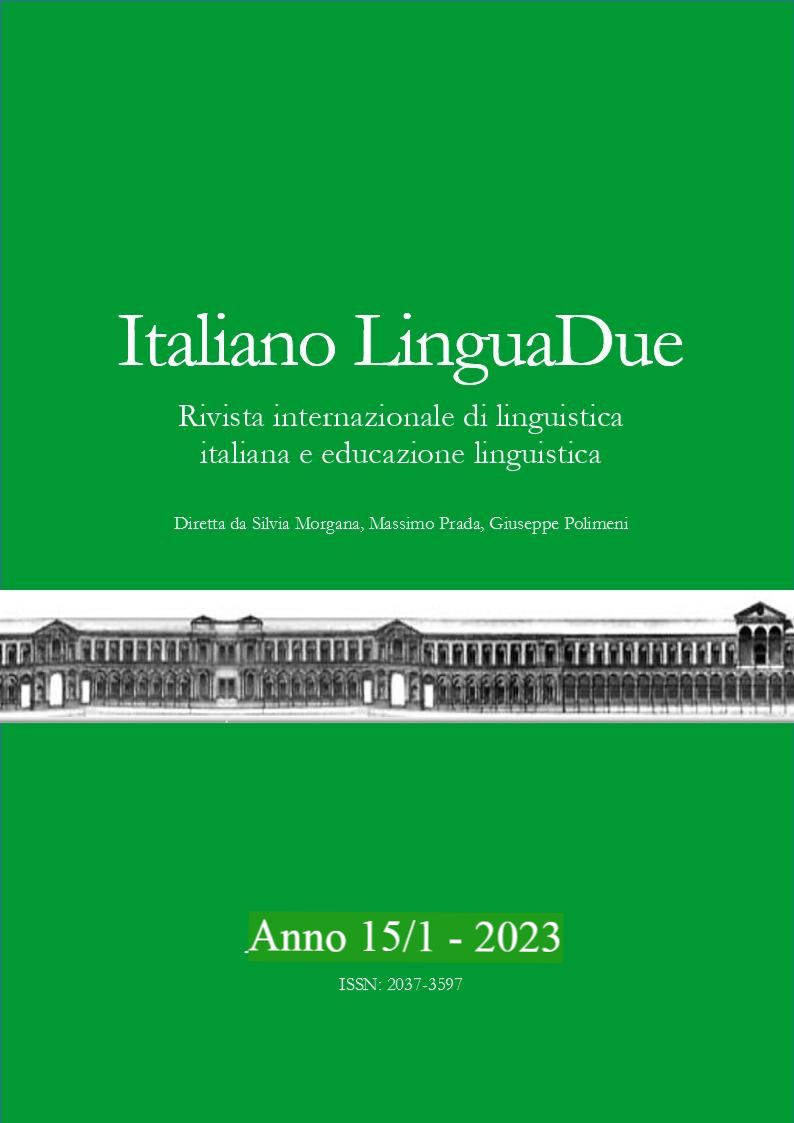L’APPROCCIO ORIENTATO ALL’AZIONE DEL “QUADRO COMUNE EUROPEO DI RIFERIMENTO PER LE LINGUE, VOLUME COMPLEMENTARE” NELLA DIDATTICA DIGITALE DELL’ITALIANO L2/LS: SCENARI E ATTIVITÀ DIDATTICHE NELLA PERCEZIONE DEGLI STUDENTI
DOI:
https://doi.org/10.54103/2037-3597/20444Abstract
Il contributo si colloca nella cornice delle principali novità introdotte dal Quadro Comune Europeo di Riferimento per le lingue - Volume Complementare, nello specifico l’Approccio Orientato all'Azione, in correlazione al concetto di apprendente come “social agent” e alla progettazione e realizzazione di scenari autentici in ambienti di apprendimento di Italiano L2/LS, all’interno di un corso universitario di didattica digitale delle lingue. Partendo da cenni al Volume Complementare e da alcuni rapporti nazionali e internazionali sull’uso delle glottotecnologie nell’era post-pandemica, si presenteranno esempi di scenari e attività didattiche realizzati da studenti non italofoni, alcuni post dei forum e estratti da interviste, con l’obiettivo di comprendere le percezioni e reazioni degli studenti stessi sul ruolo del digitale nella didattica delle lingue.
The Action-Oriented Approach of the “Common European Framework of Reference for Languages, Companion Volume” in the digital didactics of Italian L2/LS: scenarios and teaching activities in students’ perceptions
The paper is set within the framework of the main innovations introduced by the Common European Framework of Reference for Languages - Companion Volume, specifically the Action-Oriented Approach, in correlation with the concept of the learner as a "social agent" and the design and implementation of authentic scenarios in L2/FL Italian learning environments, within a university course on digital language teaching. Starting with brief references to the Companion Volume and to some national and international reports on the use of language learning technologies in the post-pandemic era, examples of scenarios and teaching activities carried out by non-Italian-speaking learners, some forum posts and excerpts from interviews will be presented, with the aim of understanding the learners' own perceptions and reactions to the role of digital in language teaching.
Riferimenti bibliografici
Balboni P. E., Margiotta U. (a cura di) (2008), Formare online i docenti di lingue e italiano L2, UTET, Torino.
Caon F., Serragiotto G. (a cura di) (2012), Tecnologie e didattica delle lingue. Teorie, risorse, sperimentazioni, UTET, Torino.
Cinganotto L., Turchetta B. (2021), “Italiano L1 e L2 in prospettiva acquisizionale e didattica: alcune riflessioni dall’analisi di un campione di testi di apprendenti adulti”, in SILTA, Studi Italiani di Linguistica Teorica e Applicata, L, 2, pp. 348-376.
Council of Europe (2019), Council Recommendation of 22 May 2019 on a comprehensive approach to the teaching and learning of languages:
https://eur-lex.europa.eu/legal-content/EN/TXT/PDF/?uri=CELEX:32019H0605(02).
Council of Europe (2020), Common European Framework of Reference for Languages: learning, teaching, assessment. Companion volume, Strasbourg: https://rm.coe.int/common-european-framework-of-reference-for-languages-learning-teaching/16809ea0d4. Trad it. a cura di Barsi M., Lugarini E., Quadro comune europeo di riferimento per le lingue: apprendimento, insegnamento, valutazione. Volume complementare, in Italiano LinguaDue, 12, 2, 2020: https://riviste.unimi.it/index.php/promoitals/article/view/15120.
Council of Europe (2022), Enriching 21st century language education, Council of Europe, Strasbourg: https://rm.coe.int/enriching-21st-century-language-education-the-cefr-companion-volume-in/1680a6e00f.
European Commission (2014), Improving the effectiveness of language learning: CLIL and Computer Assisted Language Learning:
https://ec.europa.eu/assets/eac/languages/library/studies/clil-call_en.pdf.
Fratter I., Jafrancesco E. (a cura di) (2014), Guida alla formazione del docente di lingue all’uso delle TIC. Le lingue straniere e l’italiano L2, Aracne, Roma. Kozulin A. (2018), “Mediation and Internalization. Conceptual Analysis and Practical Applications”, in Lantolf J. P., Poehner M. E., Swain M. (eds.), The Routledge handbook of sociocultural theory and second language development, Routledge, London-NewYork.
La Grassa M., Troncarelli D. (2016) (a cura di), Una bussola per orientare la didattica con le tecnologie digitali, Becarelli, Siena. Lantolf J. P. (ed.) (2000), Sociocultural theory and second language learning, Oxford University Press, Oxford.
Motteram G. (2013), Innovations in Learning Technologies for English Language Teaching, British Council, London.
Nunan D. (2004), Task-Based Language Teaching, Cambridge University Press, Cambridge.
Peppoloni D. (2019), Per una didattica digitale delle lingue, Mondadori, Milano. Piccardo E. (2012), “Médiation et apprentissage des langues: pourquoi est-il temps de réfléchir à cette notion?”, in ELA: Études de Linguistique Appliquée, 167, pp. 285-297.
Piccardo E. (2020), “La mediazione al cuore dell’apprendimento linguistico per una didattica 3.0.”, in Italiano LinguaDue, 12, 1, pp. 561-585:
https://riviste.unimi.it/index.php/promoitals/article/view/13946.
Piccardo E., North B. (2019), The action-oriented approach: a dynamic vision of language education, Multilingual Matters, Bristol.
Richards J. C. (2013), “Curriculum approaches in language teaching: Forward, central and backward design”, in RELC Journal, 44, 1, pp. 5-33.
Stanley G. (2013), Language Learning with Technology: Ideas for Integrating Technology in the Classroom, Cambridge University Press, Cambridge.
Tavosanis M. (2019), “Il rapporto tra le tecnologie, il cambiamento linguistico e l’educazione linguistica”, in Coppola D. (a cura di), Educazione linguistica e insegnamento, Edizioni ETS, Pisa.
Townend N., Bartosik A., Folinazzo G., Kelly J. (2022), “Teachers implementing action-oriented scenarios: Realities of the twenty-first century classroom”, in Piccardo E., Lawrence G., Germain Rutherford A., Galante A. (eds.), Activating Linguistic and Cultural Diversity in the Language Classroom, Springer International Publishing, New York, pp. 179-234.
Villarini A. (a cura di), (2010), L’apprendimento a distanza dell’italiano come lingua straniera. Modelli teorici e proposte didattiche, Le Monnier, Firenze.
Ward C. (ed.) (2010), The impact of technology on language learning and teaching: What, How and Why, Regional Language Centre, Singapore.
Willis J. (1996), A Framework for task-based learning, Longman, London.
Dowloads
Pubblicato
Fascicolo
Sezione
Licenza
Copyright (c) 2023 Italiano LinguaDue

Questo lavoro è fornito con la licenza Creative Commons Attribuzione - Condividi allo stesso modo 4.0.




